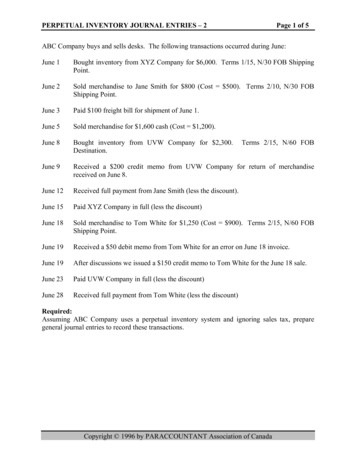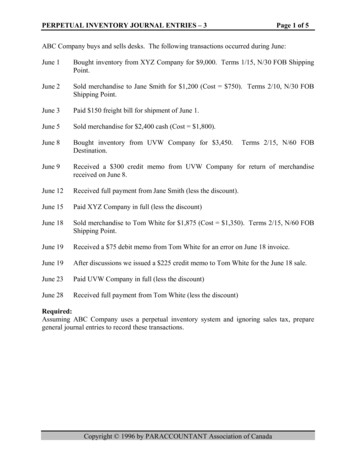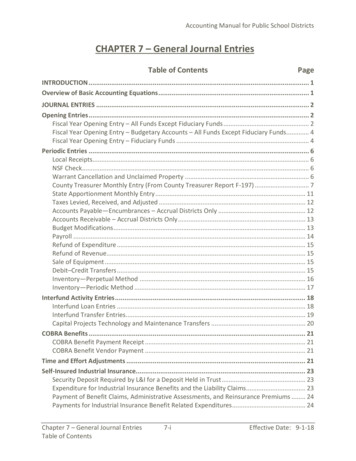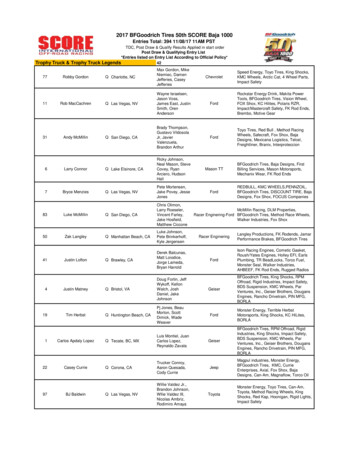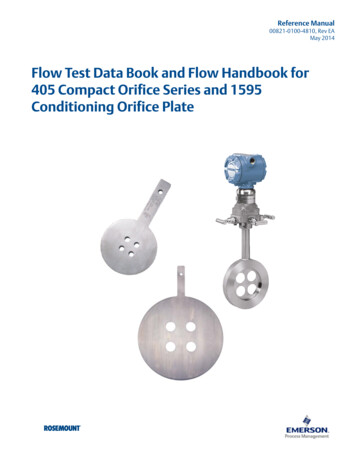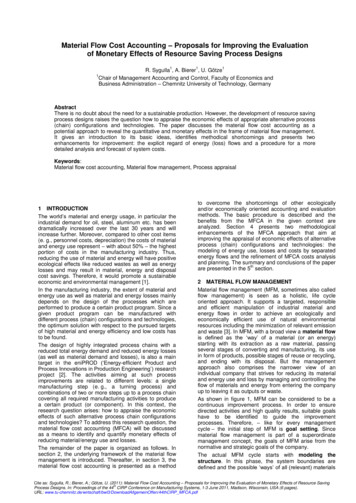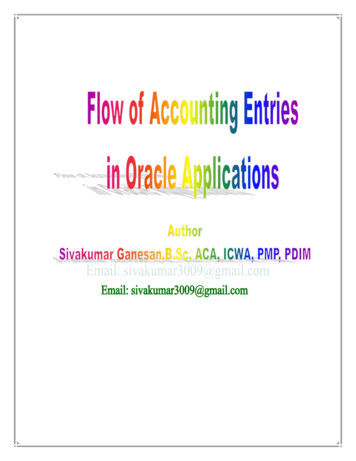
Transcription
Objective: This Document is to make the user to understand the flow of accounting in Oracleapplications, in Purchasing, Manufacturing, Inventory, Order Management and Financial ModulesPayables, Receivables, Cash management and General ledger and not to cover all scenarios andBusiness cycles. I have not covered few other modules like Fixed Assets, Projects, Treasury,Payroll, Encumbrance etc., in this Document which also generates accounting entries. This Doesnot cover the technical aspects like, Table, columns etc., for which you have standard diagnosticsscripts which can be run and viewed for every activity.Business Case: Parry Confectionery Ltd is Manufacturers of Coffee Bite, Caramilk, CoconutPunch, Lacto King, Orange Candy variety of Chocolates. The Chocolates Manufacturing Processis as follows Milk is Boiled to evaporate the Water content @100 Degree centigrade and it is calledBoiled MilkThen to the boiled Milk, Sugar and Cocoa are added which has the water content. This isagain boiled to evaporate all the water content to make it as Thick Liquid Milk calledCondensed MilkCondensed Milk is allowed to be allowed to pass through a drier which takes all Watercontent and make it as dry chocolate.The dry chocolates are allowed to pass through a cutting machine which cuts thechocolates into different pieces of 5 grams, 10 grams, etcThen the pieces of chocolates are passed to a wrapper machine which wraps thechocolate and pass it on to a containerThen the wrapped chocolates from the container are sent to a Packing machine whichpicks up chocolates and makes them as 500 grams, 1KG pack chocolate covers.Then the chocolates are placed in 10 kg, 20 Kg carton boxes and sent to CustomersKey Points: I am using Vision Operations to explain the flow of accountingentriesBusiness Group: Vision CorporationSet of Books: Vision OperationsOperating Unit: Vision OperationsInventory Organization: Vision Operations (Master) V1, Seattle Manufacturing(Child) M1Costing Method: Standard CostingDisclaimer: This Document was created with my own assumptions to explain theconcept of accounting and the names of the companies used in this article are only toexplain the accounting concept with data assumptions and none of the Company is notresponsible for the Data or the process information provided in this article.
Case StudyParry Confectionery Ltd is Manufacturers of Caramilk, Lactoking and Coconut Punch Chocolates.Their Statement of Affairs as on 31-Oct-2007 is as followsBalance sheet as on 31-Oct-2007LiabilitiesShare CapitalLong term Loans8% DebenturesLoan from ICICICurrent LiabilitiesSundry CreditorsTotal LiabilitiesAmount in USD50000500002500050000175000AssetsFixed AssetsBuildingPlant and MachineryInvestmentsCurrent AssetsInventorySundry DebtorsBankCashTotal AssetsAmount in USD250007500020000250002000075002500175000During the period 01-Nov-2007 to 30-Nov-2007 following Transactions took place1)a) Purchased Inventory as followsi) Milk 500 Ltrs @ 12USD per Ltr – 6000 USDii) Sugar 500 Kgs @ 10USD per Kg – 5000 USDiii) Cocoa 500 Kgs @ 25 USD per Kg – 12500 USD2) Returned Materials to Supplier is 50 Ltrs of Milk3) Made Payment To Suppliers for Milk and Sugar4) During the month 7 kgs of Caramilk, 12 Kgs of Coffee Bite and 6 Kgs of Lackto KingChocolates the Discrete job is created5) The actual completed output of the Finished Goods Items are 5 Kgs of Caramilk, 10 Kgs ofCoffeebite and 6 Kgs of Lactoking6) Sales Made during the Month is 5 Kgs of caramilk and, 10 Kgs of Coffee Bite and 4 Kgs ofLacto King7) Payment received from Customers only for Coffeebite8) Out of the Items sold 1 kg of Caramilk was spoiled for which the Customer has sent back thematerial9) One Kg of Lactoking was spoiled in Transit for which Customer need to be issued a Creditnote as Material non-returnable10) During the month the company paid following expensesa) Packing Material –100 Paid by Cashb) Advertisement – 250 Paid by Bank to OrgMarg Company11) Company withdrew 1000 USD for Office use12) Interest Income received for the month is 100 USD13) Bank charges for the month is 5 USD14) Provision for Tax to be made 500 USD15) Employees Travel Expenses Provision to be made 300 USD
(M) Finished Goods (Lacto King, Caramilk, Coffee Bite)Condensing Department10 Hours @20 USD per HrPacking Department1 Hours @ 50 USD perMilkSugarCocoa10 Ltrs @Rs10 5 Kgs @Rs10 4 Kgs @Rs25The Standard cost of a Material Item is as followsCow MilkSugarCocoa100 USD 50 USD 100 USD-------------Standard Cost250 USD Manufacturing Cost of Chocolate is as followsPurchase Standard Cost isOperations CostCondensing Dept Cost 200 USDPacking Cost50 USDManufacturing Cost250 USD250 USD-------------500 USD Selling PriceCoffee BiteCaramilkLacto King700 USD650 USD600 USD
Things to know: I hope all of you might have gone through my previous two accountingMaterials and found it useful. But you should understand there are always challenges andadvantages of using ERP system to generate the information and accounting transactions. Wewill discuss the details briefly hereImportant Points:1) In the Manual or Legacy accounting systems, we will not have the concept ofIntermediary accounting like Accruals etc.; This is a system requirement for it to performthe matching and meet the Standard accounting procedures accruals accounts need tobe created.2) The Intermediary accounts like Accruals, Inter company Transfer account etc., must bedefined as a Balance sheet account meaning either as an Asset or Liability. Why? Thereason being if you define it as Revenue or Expense Account, then it will have theimpact on Profit and Loss at the end of the period which is not correct. So keep it in mindwhenever you define an Intermediary account it must be a Balance sheet account likeAsset or Liability account type.3) The ERP system always follows perpetual system of Inventory which means the stockReceipt and Issues are accounted immediately and not using the Periodical Inventorysystem. To understand the difference between the two refer to the following URLa. .HTMLb. http://ccba.jsu.edu/accounting/MAINMENU1.HTML4) The Confectionery Industry will fall under Process manufacturing or discreteManufacturing might be a big debate, but for this exercise, I have explained only indiscrete manufacturing and I have not considered the Normal losses etc., in the Processlike Water evaporation Loss etc., in this exercise
Index1. Creation of Items, Item Costs and Bill of Material2. Loading of Opening Balances3. Transactions Creation4. Material Returned to Supplier5. Create Supplier Invoice and Make payment to Supplier6. Create Discrete Job for Coffeebite, Caramilk and Lactoking7. Create Sales Order, Book the Order, release and Ship confirm the Goods8. Payment received from Customers only for Coffeebite9. Out of the Items sold 1 kg of Caramilk was spoiled for which the Customer hassent back the material10. One Kg of Lactoking was spoiled in Transit for which Customer need to be issueda Credit note as Material non-returnable11. During the month the company paid following expensesi) Packing Material –100 Paid by Cashii) Advertisement – 250 Paid by Bank to Org Marg Company12. Company withdrew 1000 USD for Office use13. Interest Income received for the month is 100 USD14. Bank charges for the month is 5 USD15. Provision for Tax to be made 500 USD16. Employees Travel Expenses Provision to be made 300 USD17. Sub Ledger Entries Transfer to General Ledger18. Posting in General Ledger19. Running of Trial Balance, Profit and Loss Account and Balance Sheet
Introduction: The Opening Balance of Assets and Liabilities except the Receivables, Payablesand Inventory will be loaded through a Journal in any Implementation. The Payables balances willbe created from Accounts Payable and Receivables will be created from Accounts Receivablesand Inventory will be created from Inventory module using cycle counting adjustment entries.The Vision Instance will have certain transactions already created and those transactions willhave the period end balances as Opening balance. Hence for this exercise ignore the Periodbeginning balance and period closing balance and ensure the Period do not contain anytransactions.Navigation PathOracle General LedgerOthers/ RequestsParameter: Balancing Segment: CompanyPeriod: Nov-07Currency: USD
This clearly shows there are no transactions created for the period Nov-07
1. Creation of Item, Item Costs and Bill of Material (BOM)I have explained in my Procure to Pay - Order to Cash - End to End Cycle Functional Documentsin detailed steps on How to create an item, Item costs and Bill of Material in detail. So pleasereplicate the same steps to get the cost of an ItemThe Cost of the Item is as follows after we define the Item, Item costs, Resources, Departments,Routings and Bill of MaterialNavigation pathManufacturing Vision OperationsChoose Inventory Organization as M1 Seattle ManufacturingBill of Materials / Bill of MaterialQuery for Item CaramilkClick on Tools Click on Roll up costsChoose Cost type as Pending and Run the ReportView the concurrent Request when it is completed Normal
2. Loading of Opening BalancesThe Opening Balances will be loaded through Journal as on 31-Oct-2007 as per the Balancesheet provided in the case study. The Asset and Liability balances are entered as it is and onlyfor Receivables and Payables it is entered in Sub ledgers and transferred to GL and cleared theClearing account instead of using Revenue and Expenses AccountNavigation PathGeneral Ledger Super UserJournals / Enter
The Accounts Payables (Account code 2210) and Accounts Receivables (Account code 1210)have not been entered instead the Accounts Payables clearing Account (Account code 2220) andAccounts Receivables clearing Account (Account code 1247) to which the balances are createdwhich will be knocked off by the entries created from the Sub Ledgers which will reflect the OpenInvoices for Aging Purposes.
Navigation PathPayables Vision operationsInvoices / Entry / InvoicesCreate Invoices as per your individual supplier details and choose the GL Date in DistributionLines as 1-Nov-2007 which is the Opening Balances Date and choose the distribution Lineaccount as Accounts Payable Clearing Account.
Now post the above Transactions to General LedgerThis will create unposted Journal Entry as followsAccounts Payables clearing A/c Dr 50000Accounts Payables A/cCr 50000
Navigation PathReceivables, Vision OperationsTransactionsCreate Invoices equivalent to your open balances with various dates and create a Transactiontype of open Balances and attach in the revenue account Accounts Receivables ClearingAccount (Account code 1247) and create an Invoice and save the Transaction and post thetransactions to General LedgerThis will create following accounting entryAccounts Receivables (1210) A/cAccounts Receivables clearing (1247) A/cDr 20000Cr 20000The objective of doing this is to create Aging Reports in Receivables and Payables Module.
Run the Concurrent Program in ReceivablesNavigation PathReceivables, Vision OperationsInterfaces / General Ledger
View the accounting Entries in General LedgerNavigation PathGeneral Ledger, Vision OperationsJournals/ Enter / Journals
Review the JournalsNavigation PathGeneral Ledger, Vision OperationsJournals/ Enter / JournalsQuery for Status Unposted and period Nov-07Post these Journals which completes the Opening Balances are readyNote: This way we can load the opening Balances of Receivables and Payables. I have notcovered Loading the opening Balances of Inventory which can be done using MiscellaneousTransactions or using Cycle counting adjustments.
Let us review the Trial Balance to view the opening balances of the Transactions created
Let us View the Aging Reports in Payables and ReceivablesNavigation PathPayables, Vision OperationsOthers/ Requests / RunSingle RequestChoose Invoice Aging Report
Aging Report in ReceivablesNavigation PathReceivables, Vision OperationsReports / collectionsAging Report 4 Bucket
Let us run the Balance sheet and ensure that the Opening Balances are correctNote: As I mentioned before, please consider only the Period Balances for this case study andignore the YTD balance which are Vision Operations Entry BalancesNavigation PathGeneral ledger, Vision OperationsReports / FinancialCompany Balance sheet
3. Transactions CreationLet us execute the Transactions one by one as mentioned in the case study and view theirAccounting Impact1)a) Purchased Inventory as followsi) Milk 500 Ltrs @ 12USD per Ltr – 6000 USDii) Sugar 500 Kgs @ 10USD per Kg – 5000 USDiii) Cocoa 500 Kgs @ 25 USD per Kg – 12500 USDWe will create a PO for the above through supplier Nestle Ltd.Important Note: There is No actual accounting Entry Generated, when you create a PurchaseRequisition (PR) or Purchase Order (PO). If you have enabled budgetary control in GL Set ofbooks and Encumbrance Accounting in Financial Options, then Encumbrance entries are createdin Purchasing Module. Encumbrance is not covered in this Exercise.Navigation PathPurchasing, Vision OperationsPurchase orders / Purchase orders
The PO 4420 is created with Status incomplete and we need to get this approved by clickingApprove ButtonNote: The Standard cost of Milk is 10 USD per Ltr and I have created PO with the rate of USD 12to get the Purchase price variance account getting created. We will check when we receive theInventory Account at the time of inventory receipt.
Create Receipts for the Inventory ItemsNavigation PathPurchasing Vision OperationsReceiving / ReceiptsChoose Inventory Org M1Enter Purchase Order field 4420Click on Find Button
Select the check box for the inventory Received and enter the Sub inventory as Stores and Savethe Record. Receipt 9610 is created.
To view the Accounting Distribution Lines created go toNavigatio
I have explained in my Procure to Pay - Order to Cash - End to End Cycle Functional Documents in detailed steps on How to create an item, Item costs and Bill of Material in detail. So please replicate the same steps to get the cost of an Item The Cost of the Item is as follows after we define the Item, Item costs, Resources, Departments,
